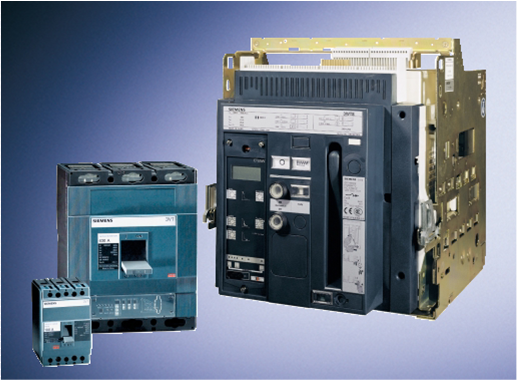
General data
Connection
The 3VT circuit-breakers are equipped with incoming and outgoing
front-accessible connecting bars which are suitable for
fixed and flexible copper bars or cables. These are suitable for
connection of standard busbars.
The incoming and outgoing connections for the circuit-breaker
can be freely selected and can be used for front or rear connection.
The electrical specifications remain the same.
Bare conductors at the top connections must be insulated in the
arc quenching space that is necessary above the arcing chambers.
Phase barriers or terminal covers can be used for this purpose.
For the 3VT circuit-breakers, the connections for the internal
accessories (auxiliary releases, auxiliary switches and alarm
switches) are supplied with terminal screws.
The auxiliary releases (shunt releases and undervoltage releases),
auxiliary switches and alarm switches for all 3VT circuitbreakers
can be connected easily and directly.
The motorized operating mechanisms are always equipped with
terminals.
Overcurrent trip unit systems
1. Overcurrent trip unit system of the VT 63 to VT630 circuitbreakers
– thermal-magnetic
The overcurrent and short-circuit releases function with bimetallic
and magnetic trip units. They are available in fixed set or adjustable
versions.
The four-pole circuit-breakers for system protection is equipped
with overcurrent trip units for all four poles.
2. Overcurrent trip unit system for VT250 to VT630 circuitbreakers,
electronic, ETU
The electronic overcurrent trip unit system consists of:
•Current transformers
• Evaluation electronics with microprocessor
• Tripping solenoid.
An auxiliary power supply is not necessary for the trip unit
system.
As is the case for all versions of the 3VT circuit-breakers with
electronic trip units, the current transformers are in the same enclosure
as the trip units. They send a signal which is proportional
to the load current to the electronic overcurrent tripping unit.
All 3VT circuit-breakers with electronic trip units measure the actual
r.m.s. current. This type of measurement is the most accurate
method. Currents in today's electrical distribution systems
with many harmonics are evaluated reliably.
A minimum load current of approx. 20 % of the corresponding
rated current In of the circuit-breaker is required to activate the
microprocessor trip units.
At the output of the electronic overcurrent trip unit module there
is a tripping solenoid which trips in the case of overload or shortcircuit.
Abbreviations (functions) L = Long Time Delay = Overload protection
S = Short Time Delay = Short-circuit protection
(short-time delayed)
I = Instantaneous = Short-circuit protection
(instantaneous)
G = Ground Fault = Ground-fault protection
L, S, I, G designations in accordance with IEC 60947
Internal accessories (auxiliary switches, undervoltage
releases, shunt releases)
The 3VT circuit-breakers can be supplied with all the internal
accessories (e.g. auxiliary switches, undervoltage releases or
shunt releases).
Fixed-mounted, plug-in or withdrawable version
The 3VT circuit-breakers are available as fixed-mounted circuitbreaker
as well as plug-in or withdrawable versions.
Operating mechanisms
The basic versions of the 3VT circuit-breakers are equipped with
a toggle lever as an operating mechanism which is also used as
a position indicator. In addition to ON and OFF, Tripped is
also indicated.
The toggle lever assumes the tripped position when the internal
tripping mechanism is activated by an overcurrent trip operation,
e.g. an overload or short-circuit. The activation of an undervoltage
release or shunt release also causes the toggle lever to
assume the tripped position. The toggle lever must be put into
the OFF/RESET position before the circuit-breakers can be reclosed.
It will then be possible to reset the internal release mechanism
and reclose the main contacts on the circuit-breaker.
|

